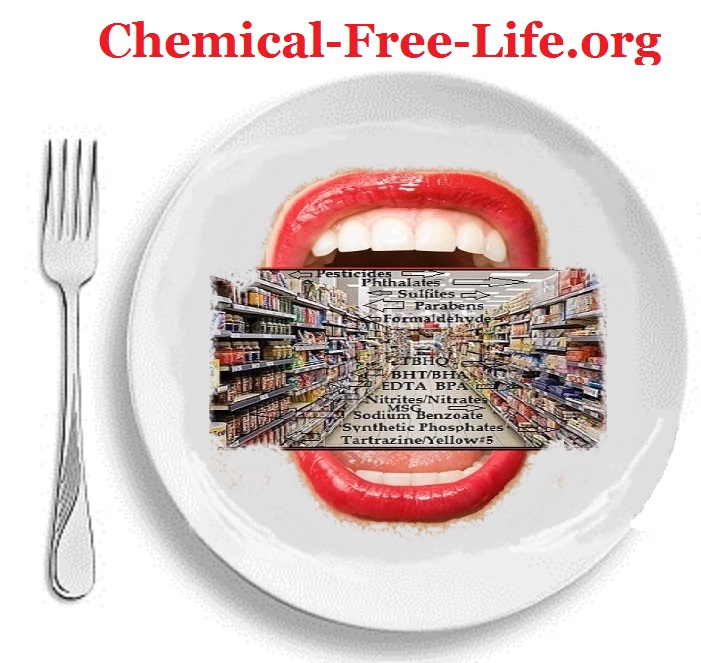Over the past decade we have published research findings on toxic synthetic chemicals in fabric that make an appearance in everything from sports bras and leggings, to t-shirts, underwear and socks, to yellow bath towels, to airline and school uniforms and children’s clothes**. Some of the chemicals scientists have found in garments include PFAS,*** tributyl phosphate, the antifungal dimethyl fumarate, disperse dyes, lead, arsenic and endocrine disrupting BPA and phthalates, among others****. Many of today’s synthetic fabric garments contain multiple potentially problematic chemicals.
Synthetic chemicals on clothing are commonly found on synthetic fabric garments like polyester, though they may also make an appearance on natural fabrics such as cotton, and may be on clothing advertised as anti-wrinkle, stain-resistant and/or as being flame-retardant. These chemicals have the potential to be acutely toxic and hazardous, triggering immune system responses that include serious skin reactions such as rashes, hives, eczema and edema, migraine headaches, difficulty concentrating, a range of allergic reactions, eye problems and breathing problems, including asthma. Yet, in the U.S. there is no safety testing of textile chemicals, no oversight from regulatory bodies***** of the chemicals that are put on clothing and consumers themselves are still largely in the dark about the practice of dangerous chemicals in their clothing or the potential health consequences.
.
What should consumers do to avoid unwanted toxic chemicals in their clothes?
Since consumers have no required “ingredients” labels to know for certain which chemical substances are used to manufacture, process, weave, dye, and finish the clothing they buy for themselves and their family, it is best to stick to clothes where the clothing designer or manufacturer expressly says on their website that their clothing does not contain problematic chemicals. Beyond this, avoid “fast fashion” clothing where there is no way to determine the chemicals used, clothing from unknown manufacturers and clothing that advertises it is anti-wrinkle, stain-resistant and/or as being flame-retardant.
–
*The Center for Environmental Health in California has found high levels of the hormone-disrupting chemical BPA in polyester-spandex socks and sports bras by dozens of large, well known brands. (source)
–
**Canadian Broadcasting Corporation had 38 pieces of children’s clothing tested from the ultra-fast-fashion brands Zaful, AliExpress, and Shein, it found that twenty percent had elevated levels of toxic chemicals such as lead, PFAS, and phthalates. (source)
–
***PFAS chemicals (per- and polyfluoroalkyl substances) are toxic to humans, animals and the environment. They are comprised of approximately 14,000 human-made chemical compounds. The chemicals are ubiquitous in the U.S., appearing in thousands of consumer and industrial products and are typically used to make products resist water, stains and heat, including household products (like carpeting, curtains, furniture upholstery, waterproof and stain-resistant flooring, etc.), cooking supplies (including cooking utensils and bake ware), clothing, personal care products (like cosmetics, including waterproof mascara, dental floss, contact lenses and feminine hygiene products) and even food (PFAS appears in processed food packaging for humans and pets), pharmaceuticals like Prozac, and public drinking water (tap water) that affects an estimated 2 million Americans. PFAS chemicals are usually found in products labeled “stain-proof” and “waterproof”. PFAS chemicals also appear in fire-fighting foam and other industrial products used at airports and military bases across the country, where the chemicals have leached into the groundwater. PFAS chemicals are known as “forever chemicals” because they do not readily break down in the environment or human body. PFAS chemicals have been linked in scientific and medical studies to a variety of serious health conditions including cancer (which includes testicular and kidney cancers), kidney disease, heart disease, thyroid problems, reproductive problems, endocrine problems (PFAS has been found to disrupt hormonal functions with some research suggesting that the PFAS chemicals are linked to accelerated ovarian aging, period irregularities and ovarian disorders like polycystic ovarian syndrome) and liver problems. Some newer PFAS have been found to accumulate in organs, so in some cases, science simply cannot detect the toxic chemicals when testing for it in blood.
–
****Laboratory tests commissioned by Alaska Airlines and the flight attendants’ union after a number of flight attendants experienced serious adverse reactions to new uniforms, turned up potentially dangerous chemicals including tributyl phosphate, lead, arsenic, cobalt, antimony, restricted disperse dyes known to cause allergic reactions, toluene, hexavalent chromium, and dimethyl fumarate, (an antifungal that is banned in the European Union). (source)
A 2018 Harvard study found that after the introduction of the uniforms, the incidents of attendants with multiple chemical sensitivity, sore throats, cough, shortness of breath, itchy skin, rashes and hives, itchy eyes, loss of voice, and blurred vision had doubled.
–
*****The European Union has banned more than 30 substances for use in fashion, but the U.S. has no such bans in existence. (source)
AS


